Critical Analysis: Web Marketing at Tesco - PM302, Spring 2018 GSM
VerifiedAdded on 2023/06/14
|51
|11483
|186
Dissertation
AI Summary
This dissertation provides a critical analysis of Tesco's use of web marketing strategies. It examines the concept of web marketing, identifies factors affecting its effectiveness (target market, technology, budget, talent), and analyzes the impact of web marketing on Tesco's business. The research employs a positivism philosophy, deductive approach, descriptive research design, and survey research strategy, using data collected from 100 Tesco customers. Key findings highlight the importance of web marketing for business organizations and its potential for customer attraction and business expansion. The dissertation concludes with recommendations for improving Tesco's web marketing approach, emphasizing the need to adapt to changing customer needs and a fiercely competitive market.
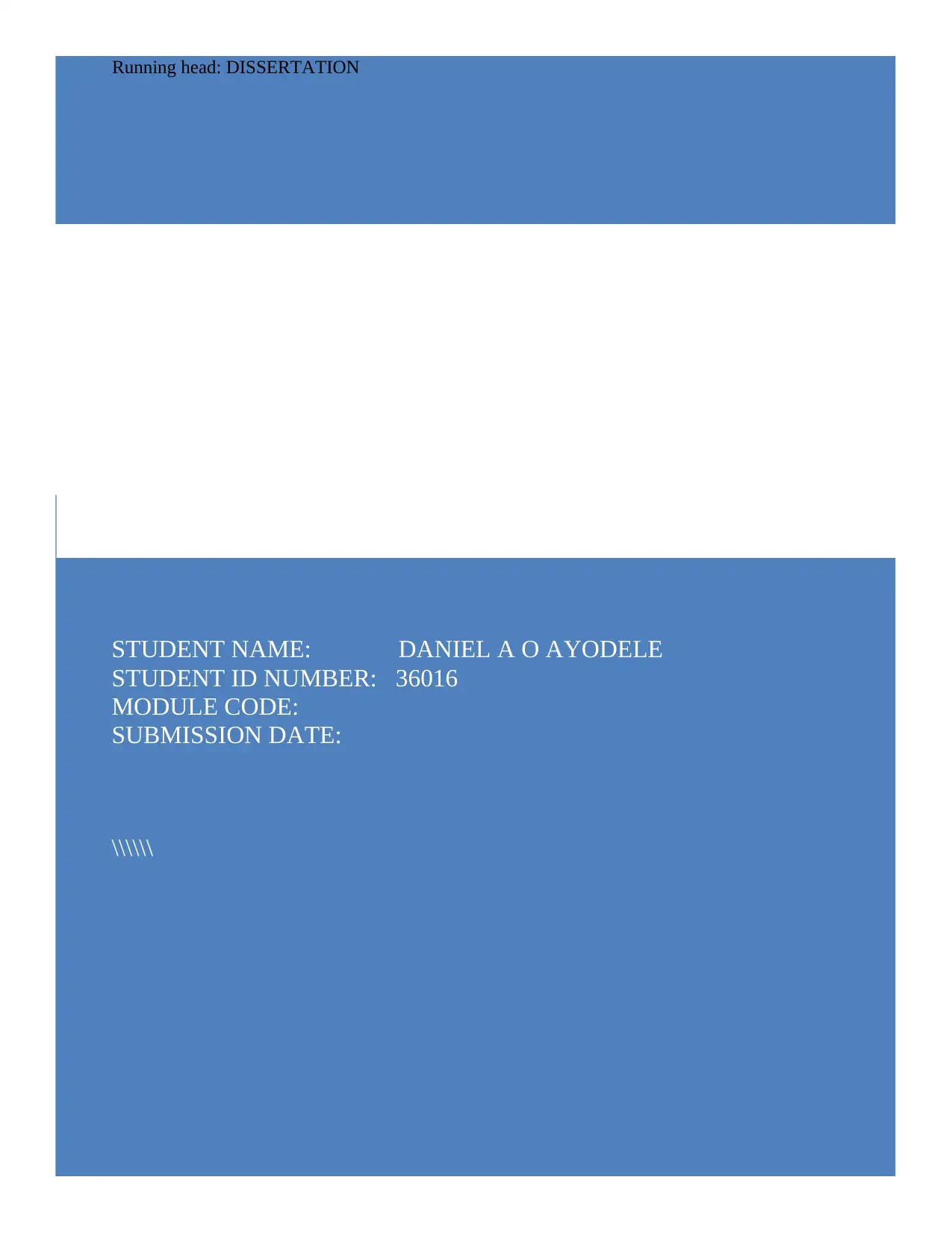
GREENWICH SCHOOL OF MANAGEMENT
(GSM)
STUDENT NAME: DANIEL A O AYODELE
STUDENT ID NUMBER: 36016
MODULE CODE:
SUBMISSION DATE:
\\\\\\
Running head: DISSERTATION
(GSM)
STUDENT NAME: DANIEL A O AYODELE
STUDENT ID NUMBER: 36016
MODULE CODE:
SUBMISSION DATE:
\\\\\\
Running head: DISSERTATION
Paraphrase This Document
Need a fresh take? Get an instant paraphrase of this document with our AI Paraphraser
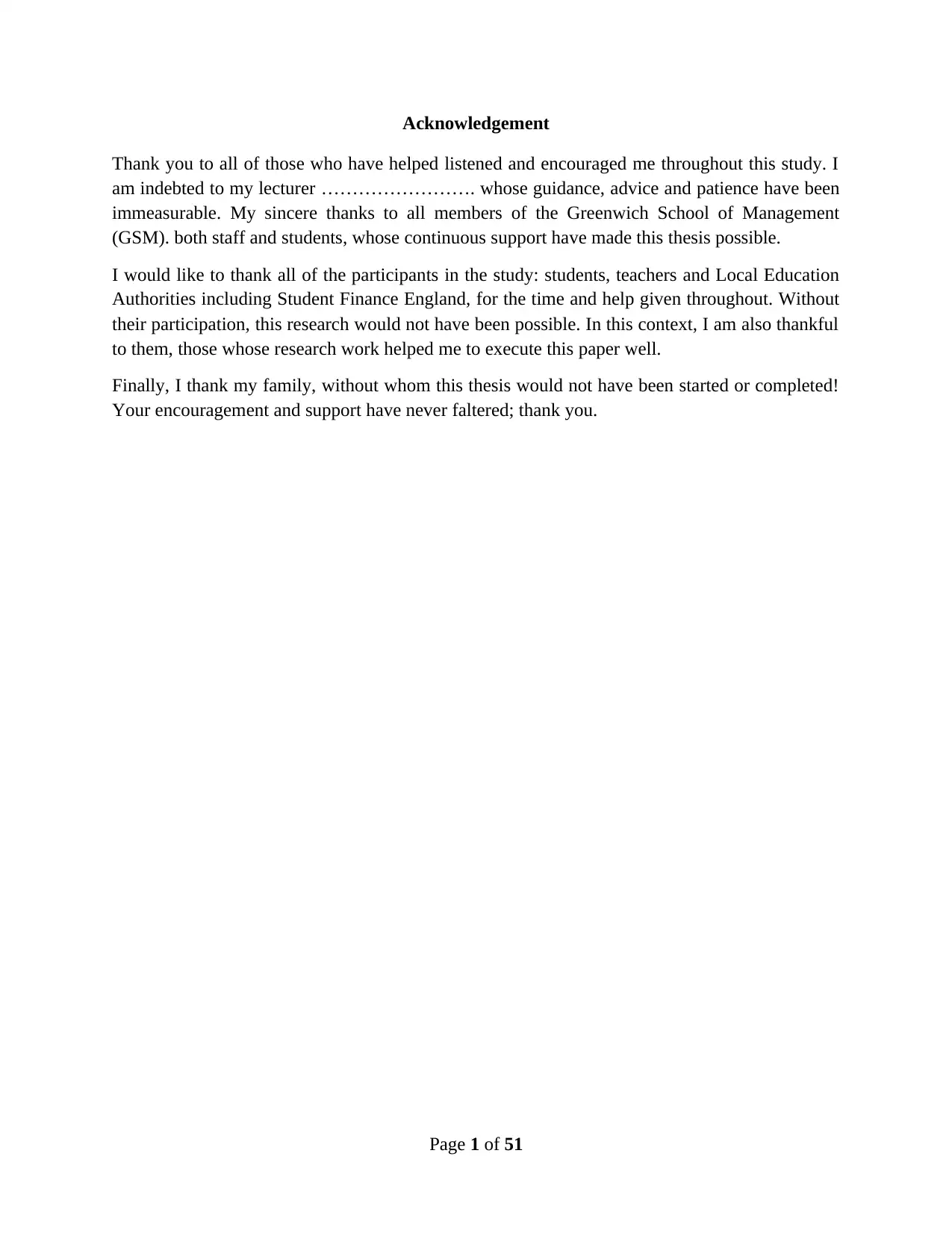
Acknowledgement
Thank you to all of those who have helped listened and encouraged me throughout this study. I
am indebted to my lecturer ……………………. whose guidance, advice and patience have been
immeasurable. My sincere thanks to all members of the Greenwich School of Management
(GSM). both staff and students, whose continuous support have made this thesis possible.
I would like to thank all of the participants in the study: students, teachers and Local Education
Authorities including Student Finance England, for the time and help given throughout. Without
their participation, this research would not have been possible. In this context, I am also thankful
to them, those whose research work helped me to execute this paper well.
Finally, I thank my family, without whom this thesis would not have been started or completed!
Your encouragement and support have never faltered; thank you.
Page 1 of 51
Thank you to all of those who have helped listened and encouraged me throughout this study. I
am indebted to my lecturer ……………………. whose guidance, advice and patience have been
immeasurable. My sincere thanks to all members of the Greenwich School of Management
(GSM). both staff and students, whose continuous support have made this thesis possible.
I would like to thank all of the participants in the study: students, teachers and Local Education
Authorities including Student Finance England, for the time and help given throughout. Without
their participation, this research would not have been possible. In this context, I am also thankful
to them, those whose research work helped me to execute this paper well.
Finally, I thank my family, without whom this thesis would not have been started or completed!
Your encouragement and support have never faltered; thank you.
Page 1 of 51

Abstract
Marketing is the strategy undertaken by the business organizations to communicate their product
and services to the target customers. It can be said that better marketing results in better customer
attraction and business expansion. However, considering the present market condition and fierce
competition, the business organizations have adopted web for marketing their products. This is
because the majorities of the customers in today’s world is web friendly and have access to the
web. Thus, reaching out to the customers around the globe is easier through the web compared to
the difficult marketing which incurred a huge cost.
The researcher also identifies the factors affecting both the variables and analyses them critically
in order to determine the effectiveness of the identified factors. The study also includes relevant
theories and models that support the concepts of both the variables. In this chapter, the researcher
analyzes the use of the web for marketing in modern day by considering the changing needs and
demands of the target market and the fiercely competitive market. The researcher has used
positivism philosophy, deductive approach, descriptive research design and survey research
strategy. The researcher has selected 100 customers of Tesco by random probability sampling
technique and analyzed the primary data collected by quantitative data analysis technique by
using SPSS, a statistical tool.
It was found that the use of web for marketing is impeccable for the business organizations.
Marketing is one of the most important business strategies that is undertaken by the business
organizations in order to communicate with the target customers. This is because appropriate
marketing provides an opportunity for the business organizations to share the properties and
description of the products with the target customers directly. As a result, the customers are able
to relate with the products and determine the suitability of the product in accordance with their
needs and demands. The business market has seen changes over the years that have led to fierce
and highly competitive market. Thus, the business organizations have used web for marketing
their products and service in order to hold better grip of the market. The use of web has several
benefits for the business organization as well as the customers.
Page 2 of 51
Marketing is the strategy undertaken by the business organizations to communicate their product
and services to the target customers. It can be said that better marketing results in better customer
attraction and business expansion. However, considering the present market condition and fierce
competition, the business organizations have adopted web for marketing their products. This is
because the majorities of the customers in today’s world is web friendly and have access to the
web. Thus, reaching out to the customers around the globe is easier through the web compared to
the difficult marketing which incurred a huge cost.
The researcher also identifies the factors affecting both the variables and analyses them critically
in order to determine the effectiveness of the identified factors. The study also includes relevant
theories and models that support the concepts of both the variables. In this chapter, the researcher
analyzes the use of the web for marketing in modern day by considering the changing needs and
demands of the target market and the fiercely competitive market. The researcher has used
positivism philosophy, deductive approach, descriptive research design and survey research
strategy. The researcher has selected 100 customers of Tesco by random probability sampling
technique and analyzed the primary data collected by quantitative data analysis technique by
using SPSS, a statistical tool.
It was found that the use of web for marketing is impeccable for the business organizations.
Marketing is one of the most important business strategies that is undertaken by the business
organizations in order to communicate with the target customers. This is because appropriate
marketing provides an opportunity for the business organizations to share the properties and
description of the products with the target customers directly. As a result, the customers are able
to relate with the products and determine the suitability of the product in accordance with their
needs and demands. The business market has seen changes over the years that have led to fierce
and highly competitive market. Thus, the business organizations have used web for marketing
their products and service in order to hold better grip of the market. The use of web has several
benefits for the business organization as well as the customers.
Page 2 of 51
⊘ This is a preview!⊘
Do you want full access?
Subscribe today to unlock all pages.

Trusted by 1+ million students worldwide
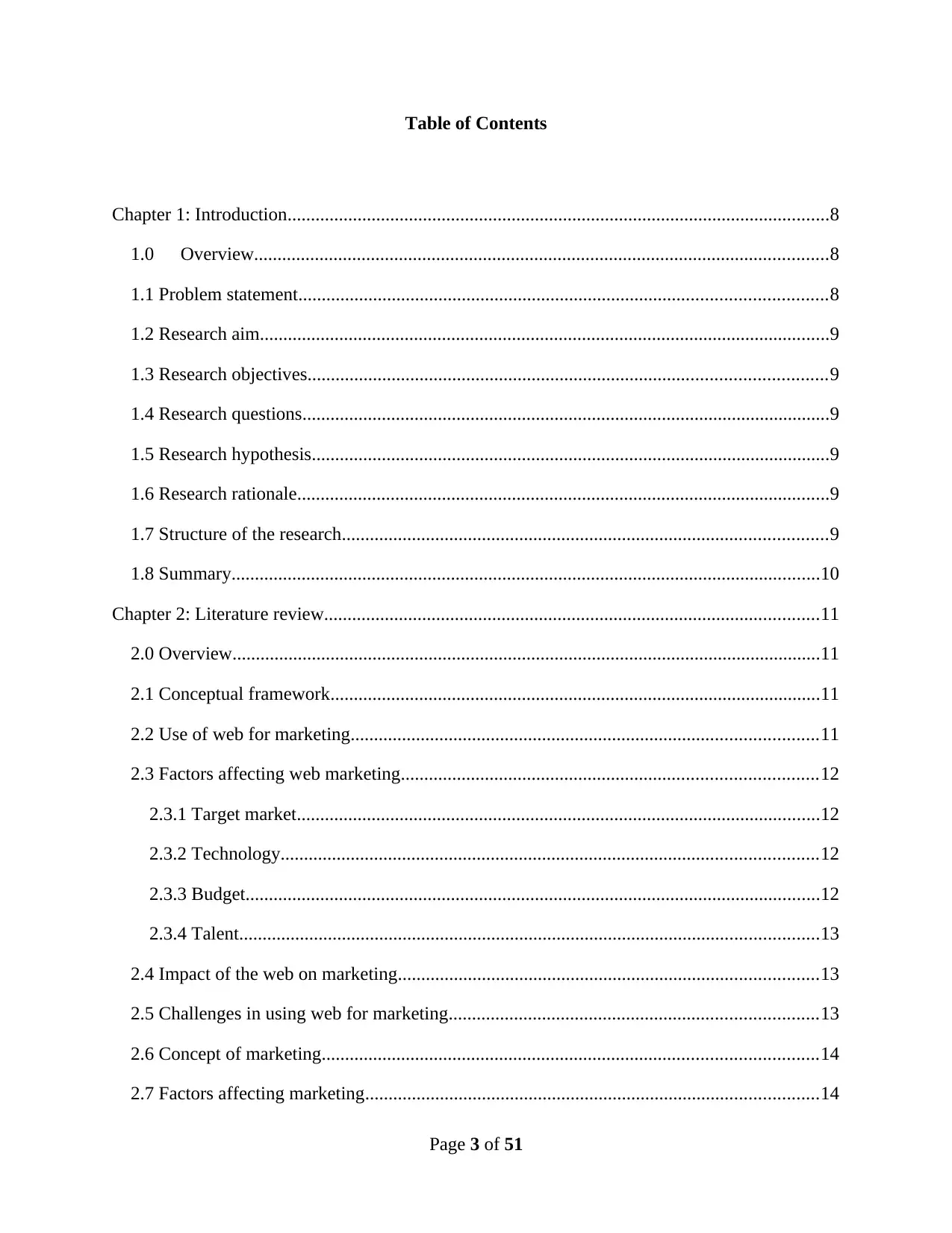
Table of Contents
Chapter 1: Introduction....................................................................................................................8
1.0 Overview...........................................................................................................................8
1.1 Problem statement.................................................................................................................8
1.2 Research aim..........................................................................................................................9
1.3 Research objectives...............................................................................................................9
1.4 Research questions.................................................................................................................9
1.5 Research hypothesis...............................................................................................................9
1.6 Research rationale..................................................................................................................9
1.7 Structure of the research........................................................................................................9
1.8 Summary..............................................................................................................................10
Chapter 2: Literature review..........................................................................................................11
2.0 Overview..............................................................................................................................11
2.1 Conceptual framework.........................................................................................................11
2.2 Use of web for marketing....................................................................................................11
2.3 Factors affecting web marketing.........................................................................................12
2.3.1 Target market................................................................................................................12
2.3.2 Technology...................................................................................................................12
2.3.3 Budget...........................................................................................................................12
2.3.4 Talent............................................................................................................................13
2.4 Impact of the web on marketing..........................................................................................13
2.5 Challenges in using web for marketing...............................................................................13
2.6 Concept of marketing..........................................................................................................14
2.7 Factors affecting marketing.................................................................................................14
Page 3 of 51
Chapter 1: Introduction....................................................................................................................8
1.0 Overview...........................................................................................................................8
1.1 Problem statement.................................................................................................................8
1.2 Research aim..........................................................................................................................9
1.3 Research objectives...............................................................................................................9
1.4 Research questions.................................................................................................................9
1.5 Research hypothesis...............................................................................................................9
1.6 Research rationale..................................................................................................................9
1.7 Structure of the research........................................................................................................9
1.8 Summary..............................................................................................................................10
Chapter 2: Literature review..........................................................................................................11
2.0 Overview..............................................................................................................................11
2.1 Conceptual framework.........................................................................................................11
2.2 Use of web for marketing....................................................................................................11
2.3 Factors affecting web marketing.........................................................................................12
2.3.1 Target market................................................................................................................12
2.3.2 Technology...................................................................................................................12
2.3.3 Budget...........................................................................................................................12
2.3.4 Talent............................................................................................................................13
2.4 Impact of the web on marketing..........................................................................................13
2.5 Challenges in using web for marketing...............................................................................13
2.6 Concept of marketing..........................................................................................................14
2.7 Factors affecting marketing.................................................................................................14
Page 3 of 51
Paraphrase This Document
Need a fresh take? Get an instant paraphrase of this document with our AI Paraphraser
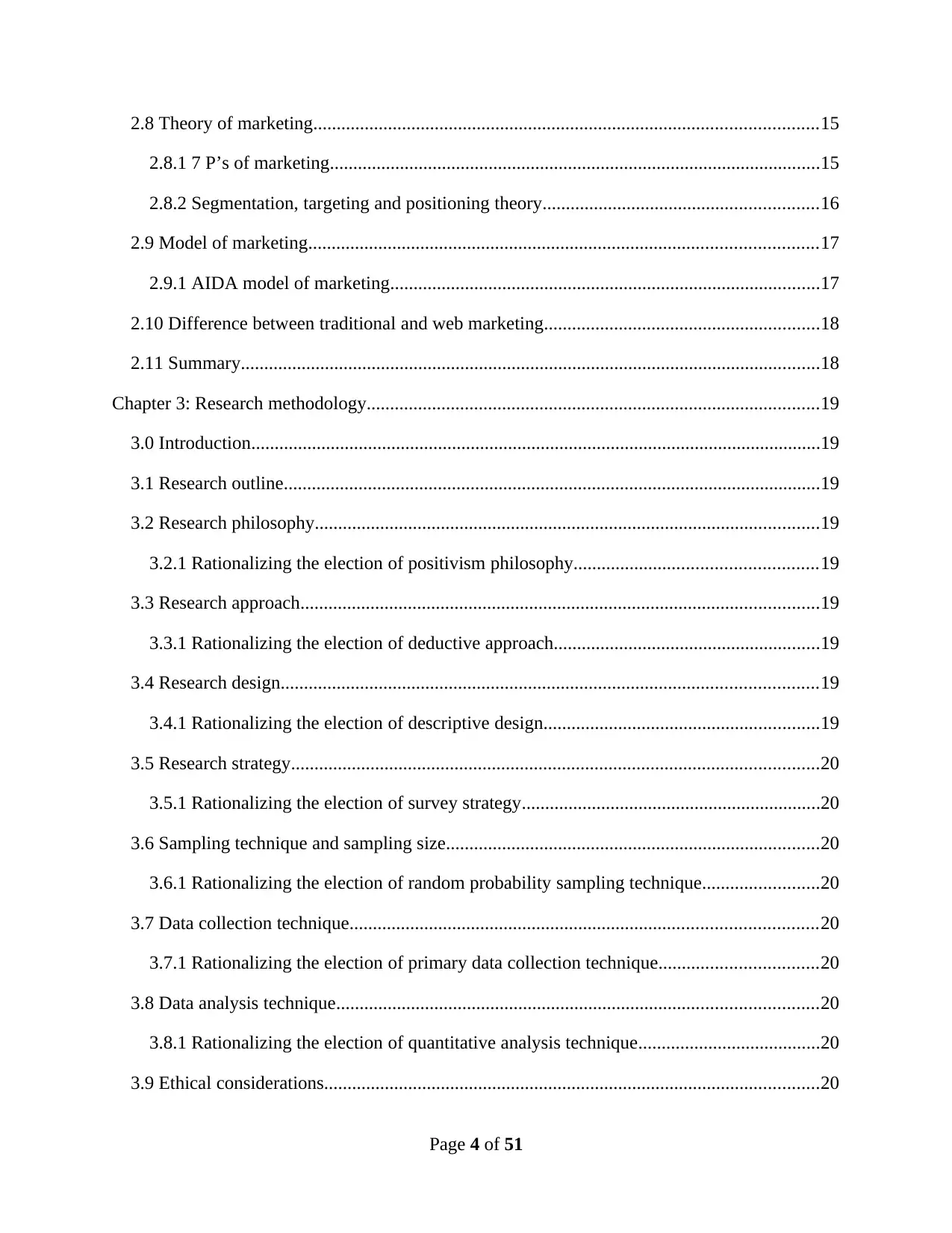
2.8 Theory of marketing............................................................................................................15
2.8.1 7 P’s of marketing.........................................................................................................15
2.8.2 Segmentation, targeting and positioning theory...........................................................16
2.9 Model of marketing.............................................................................................................17
2.9.1 AIDA model of marketing............................................................................................17
2.10 Difference between traditional and web marketing...........................................................18
2.11 Summary............................................................................................................................18
Chapter 3: Research methodology.................................................................................................19
3.0 Introduction..........................................................................................................................19
3.1 Research outline...................................................................................................................19
3.2 Research philosophy............................................................................................................19
3.2.1 Rationalizing the election of positivism philosophy....................................................19
3.3 Research approach...............................................................................................................19
3.3.1 Rationalizing the election of deductive approach.........................................................19
3.4 Research design...................................................................................................................19
3.4.1 Rationalizing the election of descriptive design...........................................................19
3.5 Research strategy.................................................................................................................20
3.5.1 Rationalizing the election of survey strategy................................................................20
3.6 Sampling technique and sampling size................................................................................20
3.6.1 Rationalizing the election of random probability sampling technique.........................20
3.7 Data collection technique....................................................................................................20
3.7.1 Rationalizing the election of primary data collection technique..................................20
3.8 Data analysis technique.......................................................................................................20
3.8.1 Rationalizing the election of quantitative analysis technique.......................................20
3.9 Ethical considerations..........................................................................................................20
Page 4 of 51
2.8.1 7 P’s of marketing.........................................................................................................15
2.8.2 Segmentation, targeting and positioning theory...........................................................16
2.9 Model of marketing.............................................................................................................17
2.9.1 AIDA model of marketing............................................................................................17
2.10 Difference between traditional and web marketing...........................................................18
2.11 Summary............................................................................................................................18
Chapter 3: Research methodology.................................................................................................19
3.0 Introduction..........................................................................................................................19
3.1 Research outline...................................................................................................................19
3.2 Research philosophy............................................................................................................19
3.2.1 Rationalizing the election of positivism philosophy....................................................19
3.3 Research approach...............................................................................................................19
3.3.1 Rationalizing the election of deductive approach.........................................................19
3.4 Research design...................................................................................................................19
3.4.1 Rationalizing the election of descriptive design...........................................................19
3.5 Research strategy.................................................................................................................20
3.5.1 Rationalizing the election of survey strategy................................................................20
3.6 Sampling technique and sampling size................................................................................20
3.6.1 Rationalizing the election of random probability sampling technique.........................20
3.7 Data collection technique....................................................................................................20
3.7.1 Rationalizing the election of primary data collection technique..................................20
3.8 Data analysis technique.......................................................................................................20
3.8.1 Rationalizing the election of quantitative analysis technique.......................................20
3.9 Ethical considerations..........................................................................................................20
Page 4 of 51
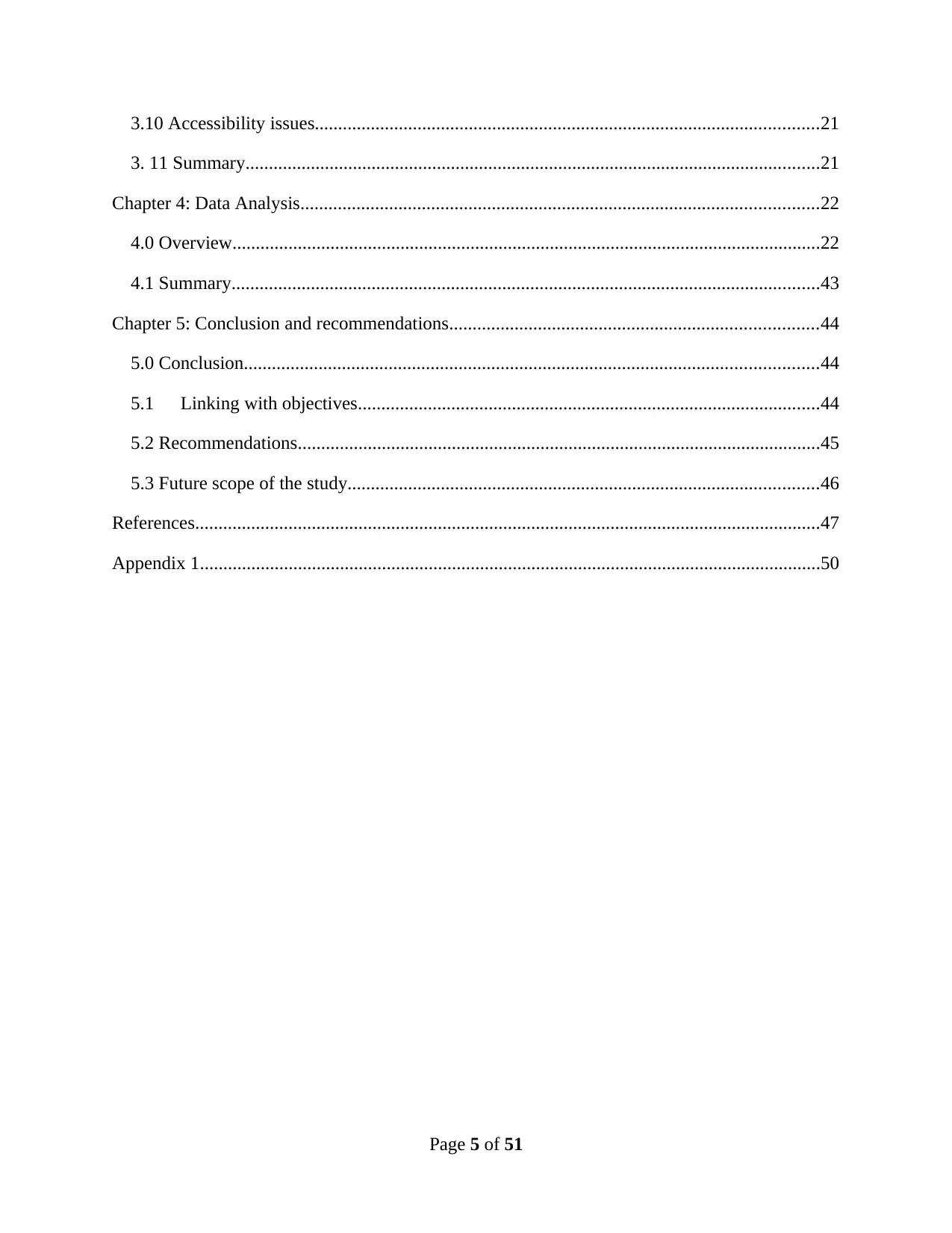
3.10 Accessibility issues............................................................................................................21
3. 11 Summary...........................................................................................................................21
Chapter 4: Data Analysis...............................................................................................................22
4.0 Overview..............................................................................................................................22
4.1 Summary..............................................................................................................................43
Chapter 5: Conclusion and recommendations...............................................................................44
5.0 Conclusion...........................................................................................................................44
5.1 Linking with objectives...................................................................................................44
5.2 Recommendations................................................................................................................45
5.3 Future scope of the study.....................................................................................................46
References......................................................................................................................................47
Appendix 1.....................................................................................................................................50
Page 5 of 51
3. 11 Summary...........................................................................................................................21
Chapter 4: Data Analysis...............................................................................................................22
4.0 Overview..............................................................................................................................22
4.1 Summary..............................................................................................................................43
Chapter 5: Conclusion and recommendations...............................................................................44
5.0 Conclusion...........................................................................................................................44
5.1 Linking with objectives...................................................................................................44
5.2 Recommendations................................................................................................................45
5.3 Future scope of the study.....................................................................................................46
References......................................................................................................................................47
Appendix 1.....................................................................................................................................50
Page 5 of 51
⊘ This is a preview!⊘
Do you want full access?
Subscribe today to unlock all pages.

Trusted by 1+ million students worldwide
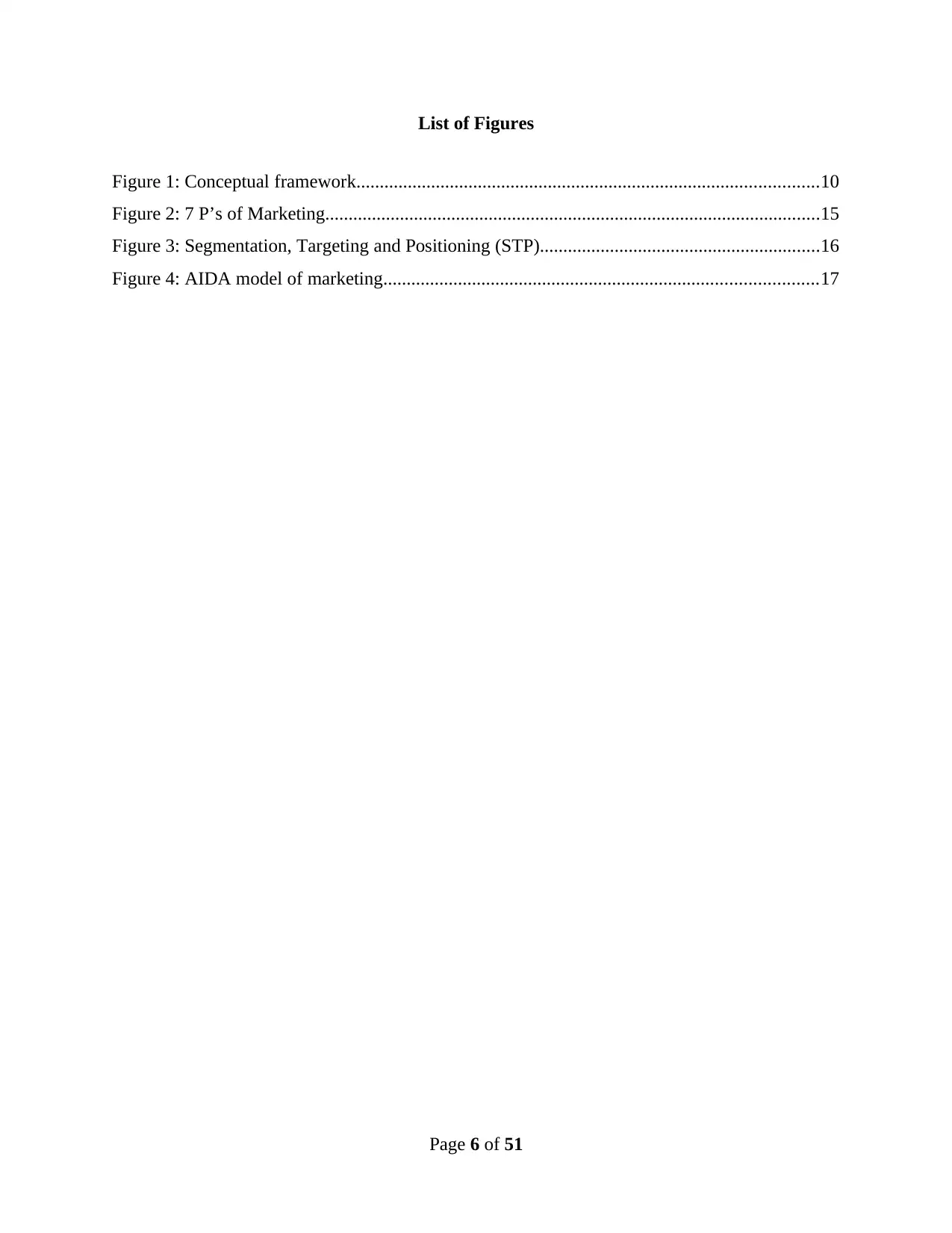
List of Figures
Figure 1: Conceptual framework...................................................................................................10
Figure 2: 7 P’s of Marketing..........................................................................................................15
Figure 3: Segmentation, Targeting and Positioning (STP)............................................................16
Figure 4: AIDA model of marketing.............................................................................................17
Page 6 of 51
Figure 1: Conceptual framework...................................................................................................10
Figure 2: 7 P’s of Marketing..........................................................................................................15
Figure 3: Segmentation, Targeting and Positioning (STP)............................................................16
Figure 4: AIDA model of marketing.............................................................................................17
Page 6 of 51
Paraphrase This Document
Need a fresh take? Get an instant paraphrase of this document with our AI Paraphraser
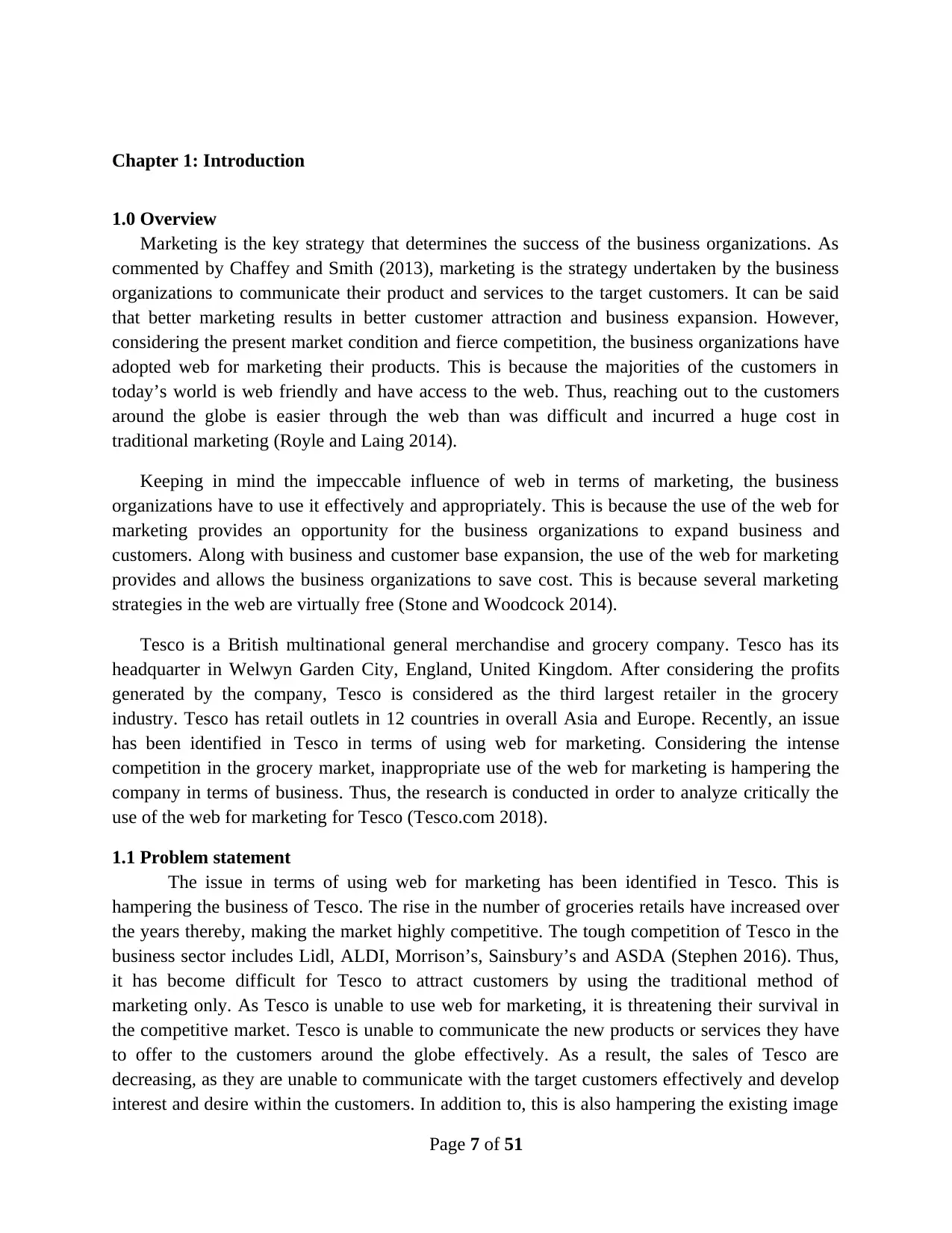
Chapter 1: Introduction
1.0 Overview
Marketing is the key strategy that determines the success of the business organizations. As
commented by Chaffey and Smith (2013), marketing is the strategy undertaken by the business
organizations to communicate their product and services to the target customers. It can be said
that better marketing results in better customer attraction and business expansion. However,
considering the present market condition and fierce competition, the business organizations have
adopted web for marketing their products. This is because the majorities of the customers in
today’s world is web friendly and have access to the web. Thus, reaching out to the customers
around the globe is easier through the web than was difficult and incurred a huge cost in
traditional marketing (Royle and Laing 2014).
Keeping in mind the impeccable influence of web in terms of marketing, the business
organizations have to use it effectively and appropriately. This is because the use of the web for
marketing provides an opportunity for the business organizations to expand business and
customers. Along with business and customer base expansion, the use of the web for marketing
provides and allows the business organizations to save cost. This is because several marketing
strategies in the web are virtually free (Stone and Woodcock 2014).
Tesco is a British multinational general merchandise and grocery company. Tesco has its
headquarter in Welwyn Garden City, England, United Kingdom. After considering the profits
generated by the company, Tesco is considered as the third largest retailer in the grocery
industry. Tesco has retail outlets in 12 countries in overall Asia and Europe. Recently, an issue
has been identified in Tesco in terms of using web for marketing. Considering the intense
competition in the grocery market, inappropriate use of the web for marketing is hampering the
company in terms of business. Thus, the research is conducted in order to analyze critically the
use of the web for marketing for Tesco (Tesco.com 2018).
1.1 Problem statement
The issue in terms of using web for marketing has been identified in Tesco. This is
hampering the business of Tesco. The rise in the number of groceries retails have increased over
the years thereby, making the market highly competitive. The tough competition of Tesco in the
business sector includes Lidl, ALDI, Morrison’s, Sainsbury’s and ASDA (Stephen 2016). Thus,
it has become difficult for Tesco to attract customers by using the traditional method of
marketing only. As Tesco is unable to use web for marketing, it is threatening their survival in
the competitive market. Tesco is unable to communicate the new products or services they have
to offer to the customers around the globe effectively. As a result, the sales of Tesco are
decreasing, as they are unable to communicate with the target customers effectively and develop
interest and desire within the customers. In addition to, this is also hampering the existing image
Page 7 of 51
1.0 Overview
Marketing is the key strategy that determines the success of the business organizations. As
commented by Chaffey and Smith (2013), marketing is the strategy undertaken by the business
organizations to communicate their product and services to the target customers. It can be said
that better marketing results in better customer attraction and business expansion. However,
considering the present market condition and fierce competition, the business organizations have
adopted web for marketing their products. This is because the majorities of the customers in
today’s world is web friendly and have access to the web. Thus, reaching out to the customers
around the globe is easier through the web than was difficult and incurred a huge cost in
traditional marketing (Royle and Laing 2014).
Keeping in mind the impeccable influence of web in terms of marketing, the business
organizations have to use it effectively and appropriately. This is because the use of the web for
marketing provides an opportunity for the business organizations to expand business and
customers. Along with business and customer base expansion, the use of the web for marketing
provides and allows the business organizations to save cost. This is because several marketing
strategies in the web are virtually free (Stone and Woodcock 2014).
Tesco is a British multinational general merchandise and grocery company. Tesco has its
headquarter in Welwyn Garden City, England, United Kingdom. After considering the profits
generated by the company, Tesco is considered as the third largest retailer in the grocery
industry. Tesco has retail outlets in 12 countries in overall Asia and Europe. Recently, an issue
has been identified in Tesco in terms of using web for marketing. Considering the intense
competition in the grocery market, inappropriate use of the web for marketing is hampering the
company in terms of business. Thus, the research is conducted in order to analyze critically the
use of the web for marketing for Tesco (Tesco.com 2018).
1.1 Problem statement
The issue in terms of using web for marketing has been identified in Tesco. This is
hampering the business of Tesco. The rise in the number of groceries retails have increased over
the years thereby, making the market highly competitive. The tough competition of Tesco in the
business sector includes Lidl, ALDI, Morrison’s, Sainsbury’s and ASDA (Stephen 2016). Thus,
it has become difficult for Tesco to attract customers by using the traditional method of
marketing only. As Tesco is unable to use web for marketing, it is threatening their survival in
the competitive market. Tesco is unable to communicate the new products or services they have
to offer to the customers around the globe effectively. As a result, the sales of Tesco are
decreasing, as they are unable to communicate with the target customers effectively and develop
interest and desire within the customers. In addition to, this is also hampering the existing image
Page 7 of 51
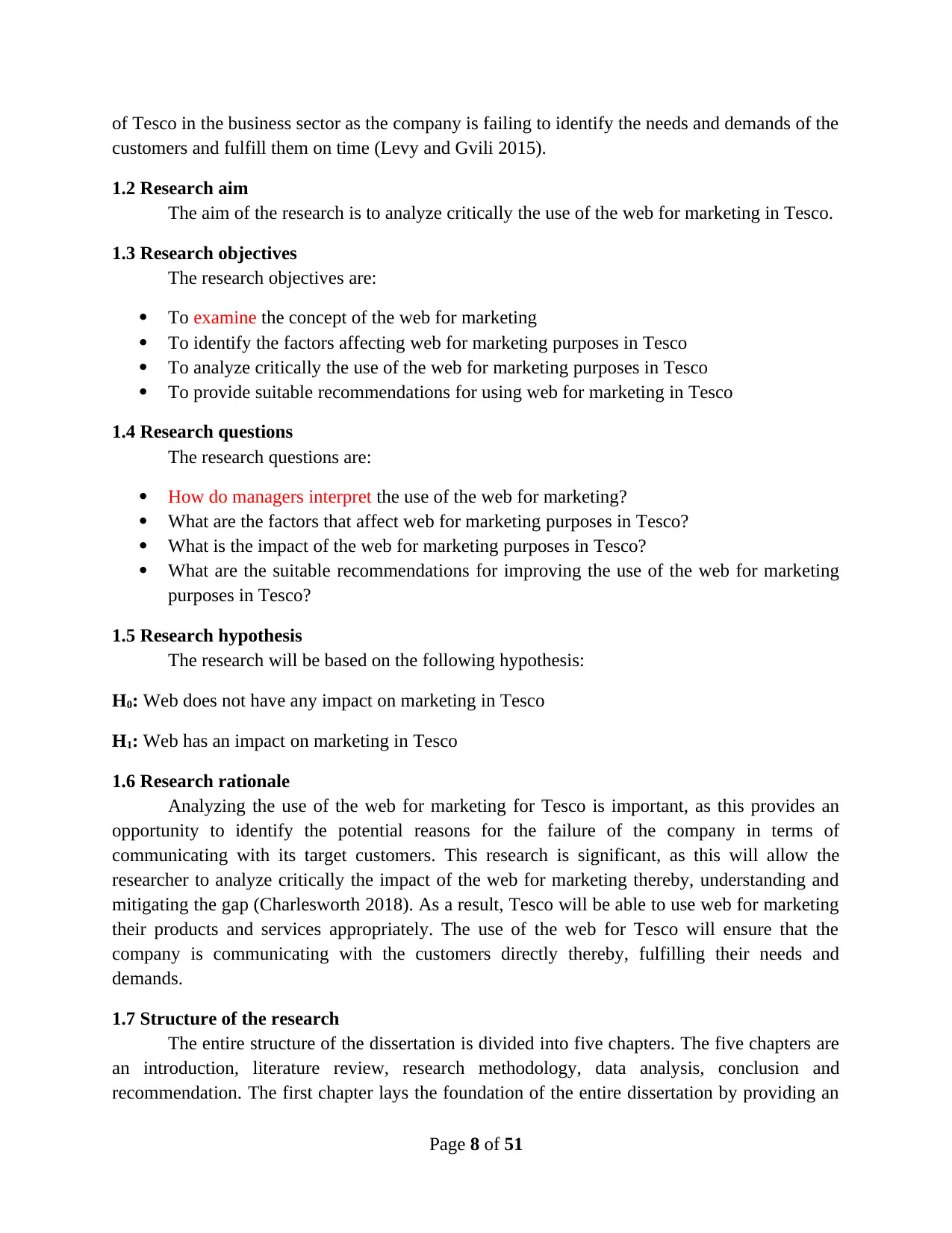
of Tesco in the business sector as the company is failing to identify the needs and demands of the
customers and fulfill them on time (Levy and Gvili 2015).
1.2 Research aim
The aim of the research is to analyze critically the use of the web for marketing in Tesco.
1.3 Research objectives
The research objectives are:
To examine the concept of the web for marketing
To identify the factors affecting web for marketing purposes in Tesco
To analyze critically the use of the web for marketing purposes in Tesco
To provide suitable recommendations for using web for marketing in Tesco
1.4 Research questions
The research questions are:
How do managers interpret the use of the web for marketing?
What are the factors that affect web for marketing purposes in Tesco?
What is the impact of the web for marketing purposes in Tesco?
What are the suitable recommendations for improving the use of the web for marketing
purposes in Tesco?
1.5 Research hypothesis
The research will be based on the following hypothesis:
H0: Web does not have any impact on marketing in Tesco
H1: Web has an impact on marketing in Tesco
1.6 Research rationale
Analyzing the use of the web for marketing for Tesco is important, as this provides an
opportunity to identify the potential reasons for the failure of the company in terms of
communicating with its target customers. This research is significant, as this will allow the
researcher to analyze critically the impact of the web for marketing thereby, understanding and
mitigating the gap (Charlesworth 2018). As a result, Tesco will be able to use web for marketing
their products and services appropriately. The use of the web for Tesco will ensure that the
company is communicating with the customers directly thereby, fulfilling their needs and
demands.
1.7 Structure of the research
The entire structure of the dissertation is divided into five chapters. The five chapters are
an introduction, literature review, research methodology, data analysis, conclusion and
recommendation. The first chapter lays the foundation of the entire dissertation by providing an
Page 8 of 51
customers and fulfill them on time (Levy and Gvili 2015).
1.2 Research aim
The aim of the research is to analyze critically the use of the web for marketing in Tesco.
1.3 Research objectives
The research objectives are:
To examine the concept of the web for marketing
To identify the factors affecting web for marketing purposes in Tesco
To analyze critically the use of the web for marketing purposes in Tesco
To provide suitable recommendations for using web for marketing in Tesco
1.4 Research questions
The research questions are:
How do managers interpret the use of the web for marketing?
What are the factors that affect web for marketing purposes in Tesco?
What is the impact of the web for marketing purposes in Tesco?
What are the suitable recommendations for improving the use of the web for marketing
purposes in Tesco?
1.5 Research hypothesis
The research will be based on the following hypothesis:
H0: Web does not have any impact on marketing in Tesco
H1: Web has an impact on marketing in Tesco
1.6 Research rationale
Analyzing the use of the web for marketing for Tesco is important, as this provides an
opportunity to identify the potential reasons for the failure of the company in terms of
communicating with its target customers. This research is significant, as this will allow the
researcher to analyze critically the impact of the web for marketing thereby, understanding and
mitigating the gap (Charlesworth 2018). As a result, Tesco will be able to use web for marketing
their products and services appropriately. The use of the web for Tesco will ensure that the
company is communicating with the customers directly thereby, fulfilling their needs and
demands.
1.7 Structure of the research
The entire structure of the dissertation is divided into five chapters. The five chapters are
an introduction, literature review, research methodology, data analysis, conclusion and
recommendation. The first chapter lays the foundation of the entire dissertation by providing an
Page 8 of 51
⊘ This is a preview!⊘
Do you want full access?
Subscribe today to unlock all pages.

Trusted by 1+ million students worldwide
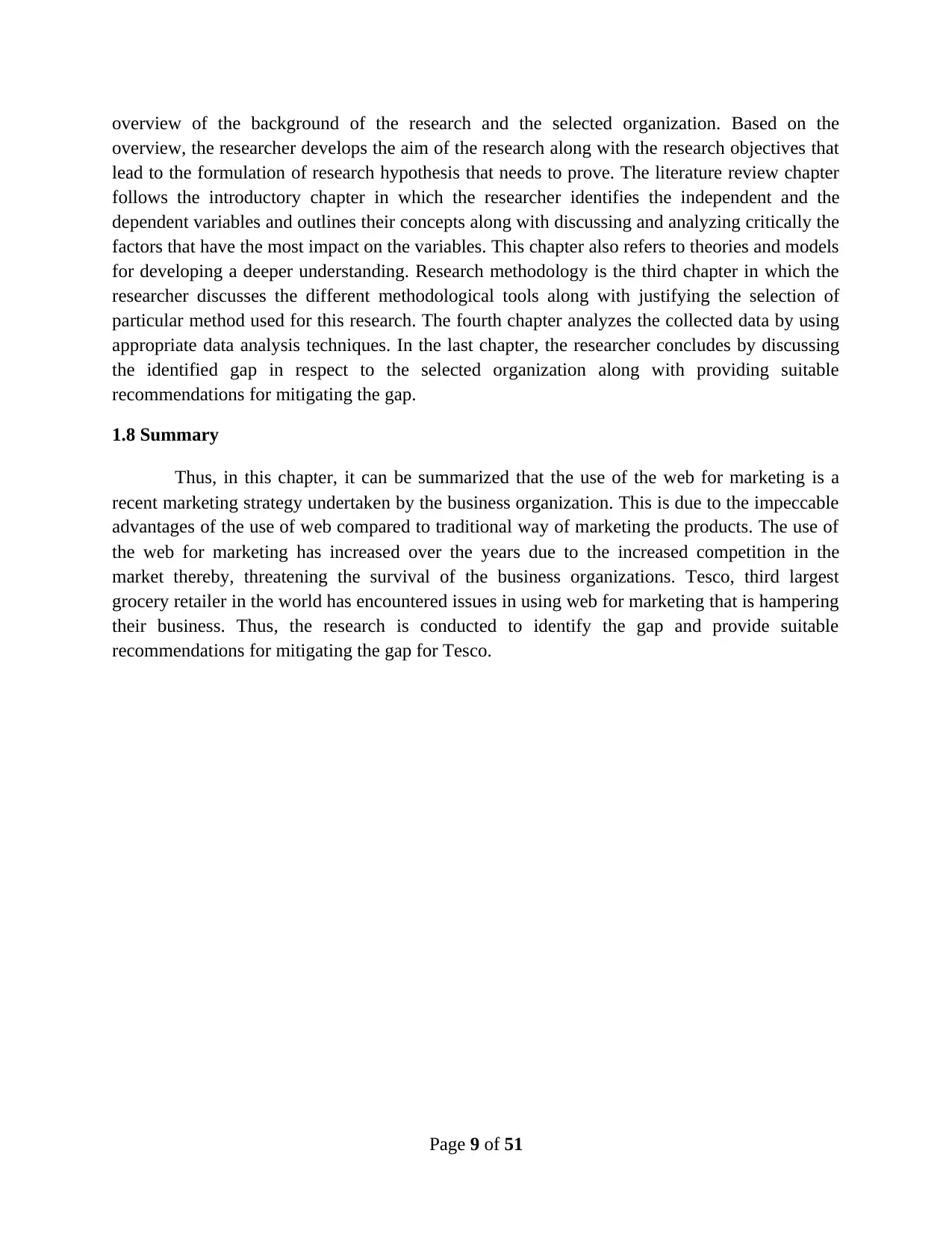
overview of the background of the research and the selected organization. Based on the
overview, the researcher develops the aim of the research along with the research objectives that
lead to the formulation of research hypothesis that needs to prove. The literature review chapter
follows the introductory chapter in which the researcher identifies the independent and the
dependent variables and outlines their concepts along with discussing and analyzing critically the
factors that have the most impact on the variables. This chapter also refers to theories and models
for developing a deeper understanding. Research methodology is the third chapter in which the
researcher discusses the different methodological tools along with justifying the selection of
particular method used for this research. The fourth chapter analyzes the collected data by using
appropriate data analysis techniques. In the last chapter, the researcher concludes by discussing
the identified gap in respect to the selected organization along with providing suitable
recommendations for mitigating the gap.
1.8 Summary
Thus, in this chapter, it can be summarized that the use of the web for marketing is a
recent marketing strategy undertaken by the business organization. This is due to the impeccable
advantages of the use of web compared to traditional way of marketing the products. The use of
the web for marketing has increased over the years due to the increased competition in the
market thereby, threatening the survival of the business organizations. Tesco, third largest
grocery retailer in the world has encountered issues in using web for marketing that is hampering
their business. Thus, the research is conducted to identify the gap and provide suitable
recommendations for mitigating the gap for Tesco.
Page 9 of 51
overview, the researcher develops the aim of the research along with the research objectives that
lead to the formulation of research hypothesis that needs to prove. The literature review chapter
follows the introductory chapter in which the researcher identifies the independent and the
dependent variables and outlines their concepts along with discussing and analyzing critically the
factors that have the most impact on the variables. This chapter also refers to theories and models
for developing a deeper understanding. Research methodology is the third chapter in which the
researcher discusses the different methodological tools along with justifying the selection of
particular method used for this research. The fourth chapter analyzes the collected data by using
appropriate data analysis techniques. In the last chapter, the researcher concludes by discussing
the identified gap in respect to the selected organization along with providing suitable
recommendations for mitigating the gap.
1.8 Summary
Thus, in this chapter, it can be summarized that the use of the web for marketing is a
recent marketing strategy undertaken by the business organization. This is due to the impeccable
advantages of the use of web compared to traditional way of marketing the products. The use of
the web for marketing has increased over the years due to the increased competition in the
market thereby, threatening the survival of the business organizations. Tesco, third largest
grocery retailer in the world has encountered issues in using web for marketing that is hampering
their business. Thus, the research is conducted to identify the gap and provide suitable
recommendations for mitigating the gap for Tesco.
Page 9 of 51
Paraphrase This Document
Need a fresh take? Get an instant paraphrase of this document with our AI Paraphraser
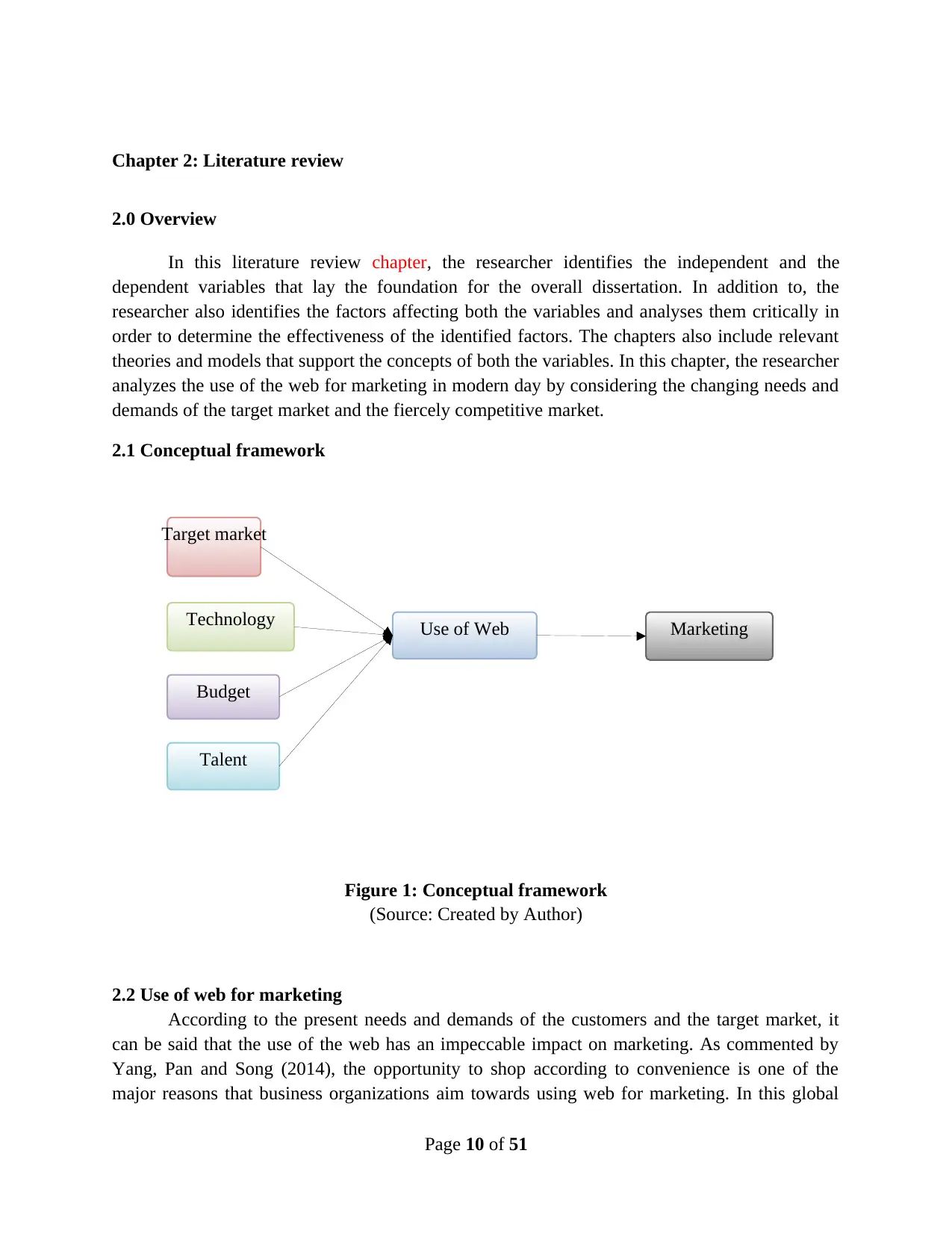
Use of Web
Target market
Technology
Budget
Talent
Marketing
Chapter 2: Literature review
2.0 Overview
In this literature review chapter, the researcher identifies the independent and the
dependent variables that lay the foundation for the overall dissertation. In addition to, the
researcher also identifies the factors affecting both the variables and analyses them critically in
order to determine the effectiveness of the identified factors. The chapters also include relevant
theories and models that support the concepts of both the variables. In this chapter, the researcher
analyzes the use of the web for marketing in modern day by considering the changing needs and
demands of the target market and the fiercely competitive market.
2.1 Conceptual framework
Figure 1: Conceptual framework
(Source: Created by Author)
2.2 Use of web for marketing
According to the present needs and demands of the customers and the target market, it
can be said that the use of the web has an impeccable impact on marketing. As commented by
Yang, Pan and Song (2014), the opportunity to shop according to convenience is one of the
major reasons that business organizations aim towards using web for marketing. In this global
Page 10 of 51
Target market
Technology
Budget
Talent
Marketing
Chapter 2: Literature review
2.0 Overview
In this literature review chapter, the researcher identifies the independent and the
dependent variables that lay the foundation for the overall dissertation. In addition to, the
researcher also identifies the factors affecting both the variables and analyses them critically in
order to determine the effectiveness of the identified factors. The chapters also include relevant
theories and models that support the concepts of both the variables. In this chapter, the researcher
analyzes the use of the web for marketing in modern day by considering the changing needs and
demands of the target market and the fiercely competitive market.
2.1 Conceptual framework
Figure 1: Conceptual framework
(Source: Created by Author)
2.2 Use of web for marketing
According to the present needs and demands of the customers and the target market, it
can be said that the use of the web has an impeccable impact on marketing. As commented by
Yang, Pan and Song (2014), the opportunity to shop according to convenience is one of the
major reasons that business organizations aim towards using web for marketing. In this global
Page 10 of 51
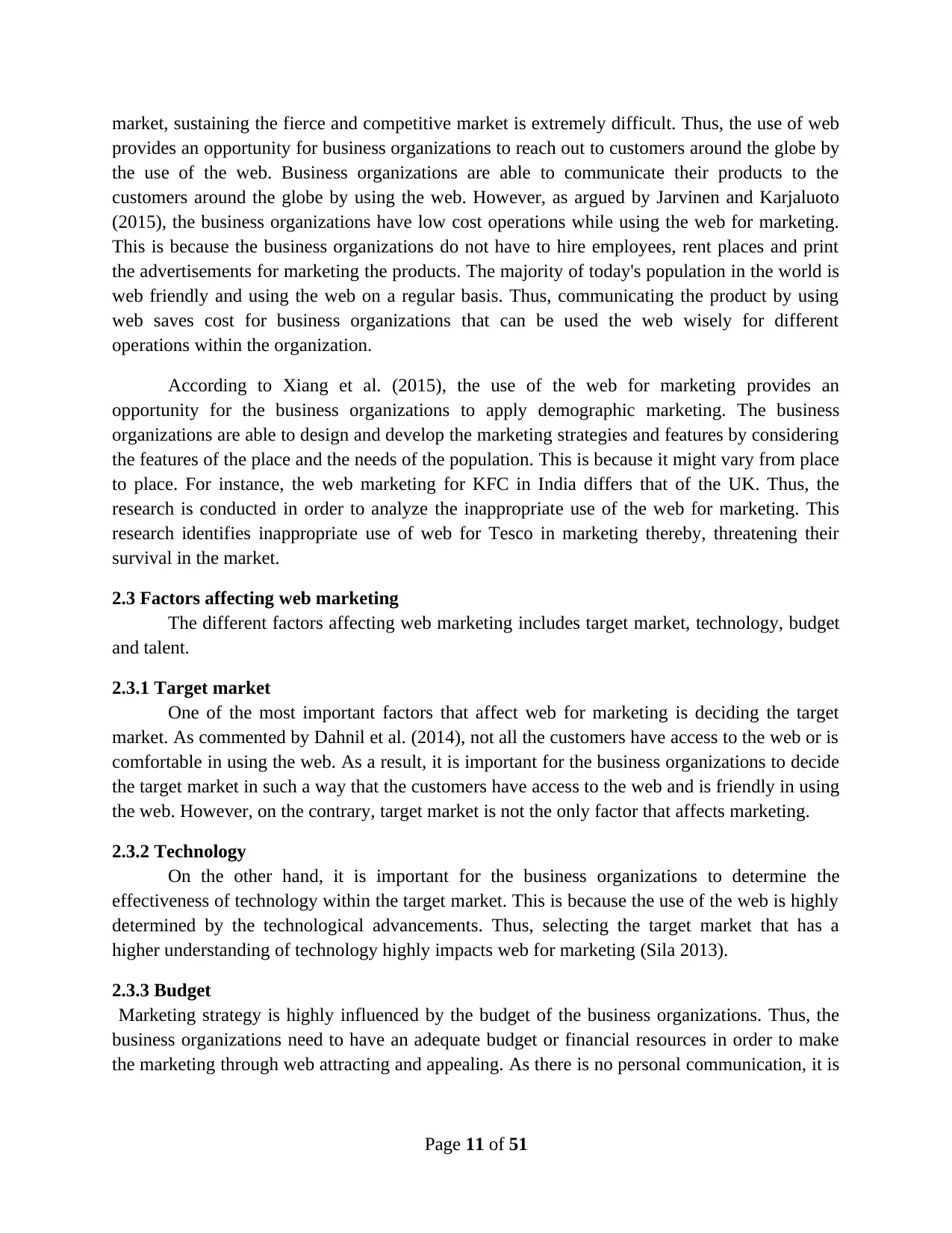
market, sustaining the fierce and competitive market is extremely difficult. Thus, the use of web
provides an opportunity for business organizations to reach out to customers around the globe by
the use of the web. Business organizations are able to communicate their products to the
customers around the globe by using the web. However, as argued by Jarvinen and Karjaluoto
(2015), the business organizations have low cost operations while using the web for marketing.
This is because the business organizations do not have to hire employees, rent places and print
the advertisements for marketing the products. The majority of today's population in the world is
web friendly and using the web on a regular basis. Thus, communicating the product by using
web saves cost for business organizations that can be used the web wisely for different
operations within the organization.
According to Xiang et al. (2015), the use of the web for marketing provides an
opportunity for the business organizations to apply demographic marketing. The business
organizations are able to design and develop the marketing strategies and features by considering
the features of the place and the needs of the population. This is because it might vary from place
to place. For instance, the web marketing for KFC in India differs that of the UK. Thus, the
research is conducted in order to analyze the inappropriate use of the web for marketing. This
research identifies inappropriate use of web for Tesco in marketing thereby, threatening their
survival in the market.
2.3 Factors affecting web marketing
The different factors affecting web marketing includes target market, technology, budget
and talent.
2.3.1 Target market
One of the most important factors that affect web for marketing is deciding the target
market. As commented by Dahnil et al. (2014), not all the customers have access to the web or is
comfortable in using the web. As a result, it is important for the business organizations to decide
the target market in such a way that the customers have access to the web and is friendly in using
the web. However, on the contrary, target market is not the only factor that affects marketing.
2.3.2 Technology
On the other hand, it is important for the business organizations to determine the
effectiveness of technology within the target market. This is because the use of the web is highly
determined by the technological advancements. Thus, selecting the target market that has a
higher understanding of technology highly impacts web for marketing (Sila 2013).
2.3.3 Budget
Marketing strategy is highly influenced by the budget of the business organizations. Thus, the
business organizations need to have an adequate budget or financial resources in order to make
the marketing through web attracting and appealing. As there is no personal communication, it is
Page 11 of 51
provides an opportunity for business organizations to reach out to customers around the globe by
the use of the web. Business organizations are able to communicate their products to the
customers around the globe by using the web. However, as argued by Jarvinen and Karjaluoto
(2015), the business organizations have low cost operations while using the web for marketing.
This is because the business organizations do not have to hire employees, rent places and print
the advertisements for marketing the products. The majority of today's population in the world is
web friendly and using the web on a regular basis. Thus, communicating the product by using
web saves cost for business organizations that can be used the web wisely for different
operations within the organization.
According to Xiang et al. (2015), the use of the web for marketing provides an
opportunity for the business organizations to apply demographic marketing. The business
organizations are able to design and develop the marketing strategies and features by considering
the features of the place and the needs of the population. This is because it might vary from place
to place. For instance, the web marketing for KFC in India differs that of the UK. Thus, the
research is conducted in order to analyze the inappropriate use of the web for marketing. This
research identifies inappropriate use of web for Tesco in marketing thereby, threatening their
survival in the market.
2.3 Factors affecting web marketing
The different factors affecting web marketing includes target market, technology, budget
and talent.
2.3.1 Target market
One of the most important factors that affect web for marketing is deciding the target
market. As commented by Dahnil et al. (2014), not all the customers have access to the web or is
comfortable in using the web. As a result, it is important for the business organizations to decide
the target market in such a way that the customers have access to the web and is friendly in using
the web. However, on the contrary, target market is not the only factor that affects marketing.
2.3.2 Technology
On the other hand, it is important for the business organizations to determine the
effectiveness of technology within the target market. This is because the use of the web is highly
determined by the technological advancements. Thus, selecting the target market that has a
higher understanding of technology highly impacts web for marketing (Sila 2013).
2.3.3 Budget
Marketing strategy is highly influenced by the budget of the business organizations. Thus, the
business organizations need to have an adequate budget or financial resources in order to make
the marketing through web attracting and appealing. As there is no personal communication, it is
Page 11 of 51
⊘ This is a preview!⊘
Do you want full access?
Subscribe today to unlock all pages.

Trusted by 1+ million students worldwide
1 out of 51
Related Documents
Your All-in-One AI-Powered Toolkit for Academic Success.
+13062052269
info@desklib.com
Available 24*7 on WhatsApp / Email
![[object Object]](/_next/static/media/star-bottom.7253800d.svg)
Unlock your academic potential
Copyright © 2020–2025 A2Z Services. All Rights Reserved. Developed and managed by ZUCOL.





